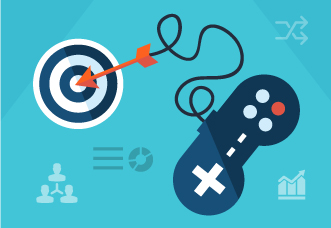


Many organizations struggle to understand why their employees initially embrace a new technology, only to walk away from it months or even weeks later. Adding to the confusion, the pattern that usually repeats itself is that they seem to gravitate toward new technology that, for the most part, offers only incremental features and capability beyond the old system or tools. Technology is changing so rapidly, it can be difficult to keep up -- but the technology is not necessarily the problem. To bolster adoption and encourage active engagement, organizations need to implement strategies that seed conversation, develop advocacy, and "gamify" their environment.

Gamification is a fascinating topic amongst collaboration and intranet specialists, as it promises to help solve some issues surrounding end user adoption and engagement -- a critical factor in the success of any collaboration platform. Using tools such as badges, leaderboards, community-driven recognition, and other social collaboration tools, gamification leverages our natural desire to come together for a common cause. It is goal-oriented, it generally incites a stronger emotional investment in the activity, and supports community. Within a corporate environment, gamification can help shape preferred behavior by rewarding individuals through recognition (or even financially) for following the right steps, completing activities on time or with few or no errors, or for helping others.
Gamification is not just about adding games to work activities, but is the broader field of behavior analysis through loyalty and motivational techniques, measured and constantly fine-tuned to reward the right behaviors.
An example I always use is the loyalty program at my local grocery store, which encourages consumer behavior by rewarding buyers with discounted gasoline and lower process. As a result of this gamification strategy, I am more apt to purchase groceries at that one location, rather than other stores that may sometimes be more convenient, because of the anticipated reward.
In an article entitled Playing Games With Developers, SDTimes editor Suzanne Kattau shares some sobering facts about the difficulties of getting a gamification strategy right. She begins by asking "Will gamification be short-lived in the enterprise due to unrealistic expectations?"
That question sums up the primary problem with the space, in my experience -- everyone loves the idea of automating systems to drive employee behavior, but few then understand what it takes to build out such a solution, maintain and monitor its progress, refine as needed, and then measure the benefits achieved. SharePoint suffers from this problem. Enormous time, expense, and effort goes into building out and deploying a SharePoint environment, and yet few organizations seem to understand that keeping people engaged also requires detailed planning and consistent attention. SharePoint is a prime example of where gamification techniques can be very effective.
Gartner reports that "80 percent of current gamified applications will fail to meet business objectives, primarily to poor design." And according to Carter Lusher, independent industry analyst formerly with Ovum Research, "While gamification has the potential to be game-changing by encouraging positive behaviors, it also has the potential to fall flat on its face if seen as just a cynical move to manipulate behavior."
A sound strategy must first establish a set proper expectations -- be open with your team and employees about what you are trying to achieve, and work closely with them to develop the right solutions that will motivate the right behaviors.
Your strategy must focus on end user objectives -- the desired behavior - and align with business processes. And it is also critical to align incentives and rewards with team and corporate culture, ensuring they will truly motivate your team. For example, many sales reps are driven by leaderboards (another gamification technique) with highly competitive rewards by day, week, month, quarter, and year, but that strategy may not span other parts of the company (marketing, operations, engineering) if your goal is to create programs across the entire company.
According to Brian Burke, an analyst at Gartner Research, there are a number of issues that a company must consider if designing a gamification strategy, including "gaming the system, forced participation, and adding work to the work." If gamification is a method for measuring adoption and engagement, then avoidance of the gamification tools or systems should be a clear signal that something is not working. Burke continues, "Gamification is not about video games: it is about motivation."
So if your metrics are showing that people are not motivated, it may be time to modify your gamification strategy.
Wondering how you can add gamification techniques into your own SharePoint environment? Beezy offers a number of capabilities that can help you get started, such as our extendable praise solution, which comes out-of-the-box with Beezy. For more information, or to schedule a private demo, please contact us at info@beezy.net
These Stories on gamification

No Comments Yet
Let us know what you think